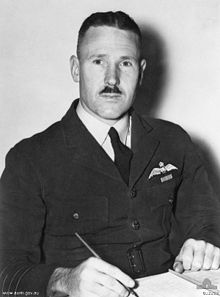Valston Hancock
| Valston Eldridge (Val) Hancock | |
|---|---|

Group Captain Val Hancock, 1942
|
|
| Born | 31 May 1907 Perth, Western Australia |
| Died | 29 September 1998 (aged 91) Perth, Western Australia |
| Allegiance | Australia |
| Service/branch | Royal Australian Air Force |
| Years of service | 1925–65 |
| Rank | Air Marshal |
| Unit |
RAAF Command (1942–43) Western Area Command (1943–44) |
| Commands held |
No. 1 BAGS (1940–41) No. 100 Squadron (1945) No. 71 Wing (1945) RAAF College (1947–49) No. 224 Group RAF (1957–59) Operational Command (1959–61) Chief of the Air Staff (1961–65) |
| Battles/wars |
World War II Malayan EmergencyIndonesia–Malaysia confrontation Vietnam War |
| Awards |
Knight Commander of the Order of the British Empire Companion of the Order of the Bath Distinguished Flying Cross |
| Relations | Lang Hancock (cousin) |
| Other work | Co-founder, Australia Defence Association |
World War II
Air Marshal Sir Valston Eldridge (Val) Hancock, KBE, CB, DFC (31 May 1907 – 29 September 1998) was a senior commander in the Royal Australian Air Force (RAAF). He served as Chief of the Air Staff from 1961 to 1965. A graduate of the Royal Military College, Duntroon, Hancock transferred to the RAAF in 1929 and qualified as a pilot. His administrative training at Duntroon saw him primarily occupy staff posts, including Deputy Director of Operations and Intelligence at RAAF Headquarters from 1931 to 1935, and Director of Works and Buildings from 1937 to 1939. During the early years of World War II, he commanded No. 1 Bombing and Gunnery School, and held senior planning and administrative positions. He eventually saw combat in the Aitape–Wewak campaign of the Pacific War during 1945. Flying Bristol Beaufort light bombers, he led first No. 100 Squadron, and later No. 71 Wing. His actions earned him the Distinguished Flying Cross.
After the war, Hancock became the inaugural commandant of RAAF College. His subsequent positions included Deputy Chief of the Air Staff from 1951 to 1953, Air Member for Personnel from 1953 to 1955, and Air Officer Commanding (AOC) No. 224 Group RAF in Malaya, responsible for all Commonwealth air forces in the region, from 1957 to 1959. Appointed a Companion of the Order of the Bath in 1958, he served as AOC RAAF Operational Command from 1959 to 1961, before being promoted to air marshal and commencing his term as Chief of the Air Staff. He was knighted in 1962. In his role as the Air Force's senior officer, Hancock initiated redevelopment of RAAF Base Learmonth in north Western Australia, as part of a chain of forward airfields for the defence of the continent. He also evaluated potential replacements for the RAAF's English Electric Canberra bomber, selecting the American "TFX" (later the General Dynamics F-111) as the most suitable for Australia's needs, though he did not recommend its immediate purchase due to its early stage of development. After his retirement from the military in May 1965, Hancock co-founded the Australia Defence Association. He died in 1998, aged 91.
...
Wikipedia
